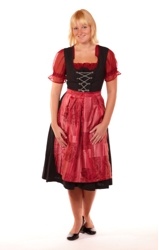The dirndl was the uniform of the Austrian servants. Traditionally,
every village even had its own particular style of this dress, in
accordance with the concept of tracht. The dirndl comprises many
garments that make up the entire outfit. It was made up of a fitted
bodice which was worn with a blouse, a full skirt, petticoat, and an
apron. The blouse was generally made of either cotton or lace. Some
women chose to wear the outfit without a blouse. The apron was more
often than not of a contrasting color. For festive occasions, the dirndl
was often accentuated with embroidery, elaborate hats, and accessories
like lace, ribbons, trims, etc., that were plaited.
Minggu, 31 Maret 2013
Rabu, 06 Maret 2013
Traditional Clothing of the World
Sri Lanka
The traditional clothing of Sri Lanka is very interesting. Women (near the age of marrying or already married) normally wear a sari, also known as Kandyan Sari as traditional clothing.

Sinhalese girls wear half saree, a cloth and jacket with a frill around shoulders. Tamil little girls wear pavadai sattai, which is pretty much a skirt with a design and a blouse. The aged Tamil girls (who have reached puberty) normally wear half sarre's which is like a saree but not fully, there would be a long scarf or cloth to put on your left shoulder and gets tucked in your skirt and it is like a pavadai sattai too!
 Sinhalese
men wear Sarong and shirt called Baniyama. And Tamil men wear patta
vetty which is a shirt and a long cloth which they wrap around their
waist.
Sinhalese
men wear Sarong and shirt called Baniyama. And Tamil men wear patta
vetty which is a shirt and a long cloth which they wrap around their
waist.
The Kandyan Saree is prepared with a long piece of Clothing of about 7 yards or more. The material of this is usually pure cotton, which is comfortable to wear since sri lanka has quite a hot climate. The picture shown on the side is of a kandyan saree which is mostly worn by the women of hill country in sri lanka.
the southern wealthy women wear the kandyan saree in a different style. But now a days many of the southern women wear the saree in the Indian style.
 An
indication of the caste system in Sri Lanka, this dress can be worn by a
particular section of the society. There are many customs and
observances that have to be carried out when making this dress as well
as in dressing it.
The
whole costume consists of many parts. They are the reli kalisama, the
viluda papu patiya, the sudu thippotiya, pachcha wadama, Somana,
Kavaniya, the velvet jacket, thoppiya with the mal gaha, the knife, the
shoes, Peras mudda, and the necklace with the medal.
An
indication of the caste system in Sri Lanka, this dress can be worn by a
particular section of the society. There are many customs and
observances that have to be carried out when making this dress as well
as in dressing it.
The
whole costume consists of many parts. They are the reli kalisama, the
viluda papu patiya, the sudu thippotiya, pachcha wadama, Somana,
Kavaniya, the velvet jacket, thoppiya with the mal gaha, the knife, the
shoes, Peras mudda, and the necklace with the medal.
The traditional clothing of Sri Lanka is very interesting. Women (near the age of marrying or already married) normally wear a sari, also known as Kandyan Sari as traditional clothing.

Sinhalese girls wear half saree, a cloth and jacket with a frill around shoulders. Tamil little girls wear pavadai sattai, which is pretty much a skirt with a design and a blouse. The aged Tamil girls (who have reached puberty) normally wear half sarre's which is like a saree but not fully, there would be a long scarf or cloth to put on your left shoulder and gets tucked in your skirt and it is like a pavadai sattai too!
 Sinhalese
men wear Sarong and shirt called Baniyama. And Tamil men wear patta
vetty which is a shirt and a long cloth which they wrap around their
waist.
Sinhalese
men wear Sarong and shirt called Baniyama. And Tamil men wear patta
vetty which is a shirt and a long cloth which they wrap around their
waist.The Kandyan Saree is prepared with a long piece of Clothing of about 7 yards or more. The material of this is usually pure cotton, which is comfortable to wear since sri lanka has quite a hot climate. The picture shown on the side is of a kandyan saree which is mostly worn by the women of hill country in sri lanka.
the southern wealthy women wear the kandyan saree in a different style. But now a days many of the southern women wear the saree in the Indian style.
Traditional costume of Sri Lanka "Udarata Mul Anduma’
The
‘Udarata Mul Anduma’ is a very important as well as impressive form of
dress. It is popular among not only kandyans as well as other Sinhalese
during their marriage and other important events. A velvet jacket, four
separated cloths, a carved knife, and four corner elaborated head gear
make the wearer fell like a knight of yore. But many fail to realize its
significance today.
‘Mul
Anduma’ has an Indian origin, believed to have been introduced to Sri
Lanka during Nanayakkar dynasty. This form of dress evolved into the
standard regalia of royal officials. It is later continued to worn by
Rate Mahattaya, Mohottala, Dissawa, and the Basnayaka Nilame.
The original ‘Mul Anduma’ comprised seven items to be worn around the waist. It has now come down to four. An
indication of the caste system in Sri Lanka, this dress can be worn by a
particular section of the society. There are many customs and
observances that have to be carried out when making this dress as well
as in dressing it.
An
indication of the caste system in Sri Lanka, this dress can be worn by a
particular section of the society. There are many customs and
observances that have to be carried out when making this dress as well
as in dressing it.13 Traditional Costumes from Around the World
So what on earth, you say, am I doing writing about traditional
clothing on a science blog? Apart from the fact that it’s interesting
and fun to look at? Partly it’s because I have a background in the
‘softer’ sciences, such as anthropology and archaeology. They don’t have
laboratory experiments, but they can still be studied in a scientific
way. But also, clothes are something that even little kids are familiar
with, and they can start to make links between clothes and where people
live or do comparisons.
For example, if you compare
For example, if you compare
-
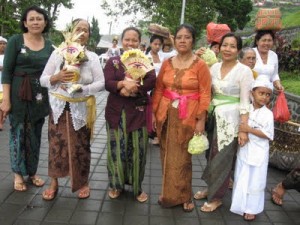
Balinese -
Bali and the Caribbean are far apart, but they are both tropical islands and developed relatively similar clothes to help cope with the weather.
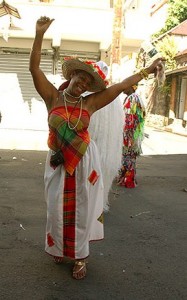
Caribbean -
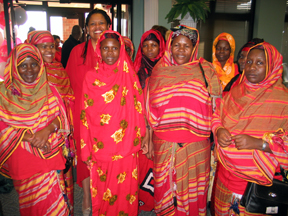
Sudanese -
Especially if you then add in these very hot countries.

Sari from India -
Historically, both India and Mongolia were part of the Silk Road, which can be seen in the materials they use. And the Mongolian clothing is extremely practical for a nomadic lifestyle, where everything needs to be carried and a blizzard may blow up out of nowhere.

Mongolian -

Swedish -
Both Sweden and Peru are significantly colder, plus the materials used in Peruvian clothing are unique – llama wool.

Peru -

Greece -
Ethiopia is hot but cooler than other parts of Africa because of its plateau. And it has historical ties with both Africa and the Mediterranean.

Ethiopia -
And then there are the whole range of clothes that aren’t made from woven cloth but local materials such as leather,
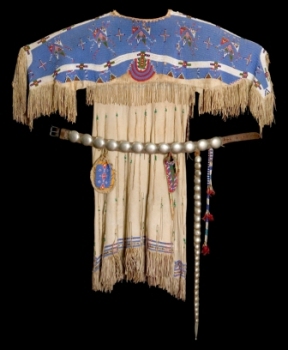
Lakota -
fur,
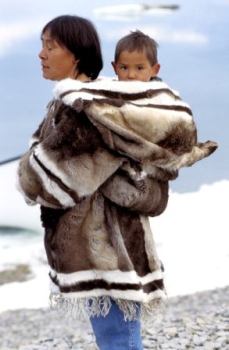
Inuit -
or at the other end of the climate scale, leaves, bones and feathers. (Did you know the semi-official name of one of the traditional New Guinean costumes is arse-grass?)
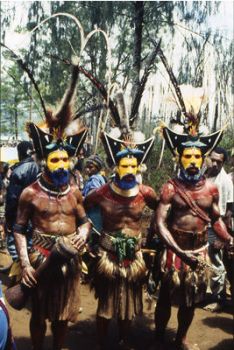
Papua New Guinea -
And here we have one of my favourites, the Torres Strait Islands. The reason I like these is because they are a brilliant demonstration that culture is not static, but dynamic and living. Part of their traditional costume is a grass skirt, and in the past these were your standard pale yellow. But the colours used in their flag are symbolic – blue for the sea, green for the land, white for peace and black for the people. And it just so happens that plastic shopping bags come in these colours. I’ve seen Torres Strait Islander people dancing in skirts that are made from plastic strips rather than grass, which isn’t somehow a step backwards, but shows how they can incorporate their traditions while taking advantage of the modern world.
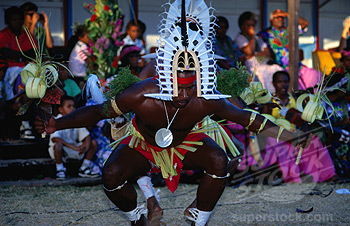
Torres Strait Islands
http://science-at-home.org/13-traditional-costumes-from-around-the-world/
Langganan:
Postingan (Atom)
